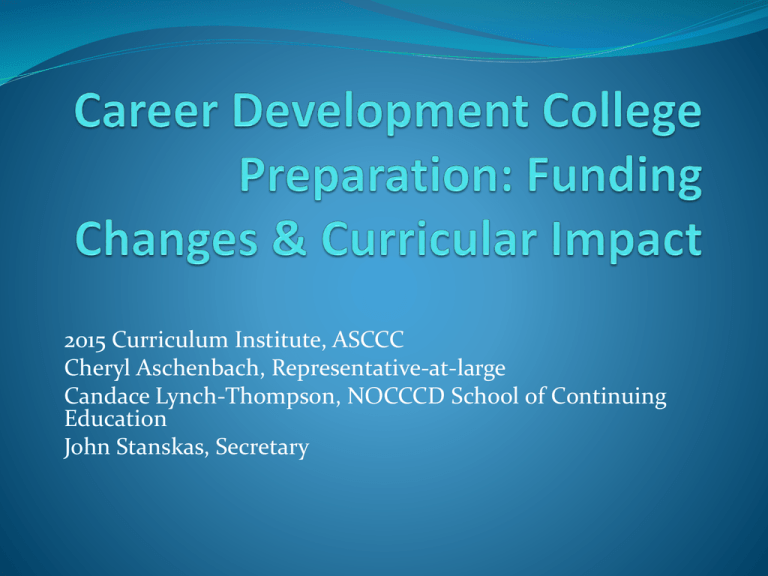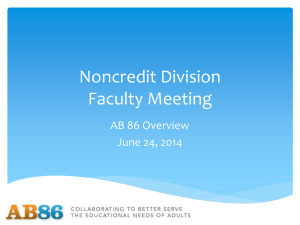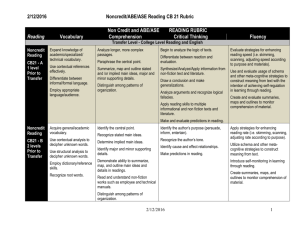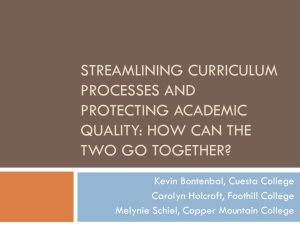Career Development College Preparation: Funding
advertisement

2015 Curriculum Institute, ASCCC Cheryl Aschenbach, Representative-at-large Candace Lynch-Thompson, NOCCCD School of Continuing Education John Stanskas, Secretary Noncredit – A Quick History Evolution of noncredit Funding CDCP (Enhanced Noncredit) Funding Equalization Accountability CB21 Progress Indicators Noncredit Courses 10 categories of noncredit courses are eligible for state funding (§58160, CB22) (p. 96 and 190 of PCAH, Program Course Approval Handbook, 5th Edition) English as a Second Language Immigrant Education (including citizenship) Elementary and Secondary Basic Skills (incl. supervised tutoring) Health and Safety Courses for Adults with Substantial Disabilities Parenting Home Economics Courses for Older Adults Short-Term Vocational (incl. apprenticeship) Workforce Preparation Future funding under AB86 is limited to the 5 areas listed in blue above CDCP SB361 (2006) increased noncredit funding in CDCP (Career Development College Preparation) courses from $2626 to $3092 per FTES CDCP courses must be sequenced and lead to certificates CDCP Enhanced Funding Categories: ESL Math and English Basic Skills Short-term Vocational Workforce Preparation (speaking, listening, reading, writing, mathematics, decision-making, and problem solving skills that are necessary to participate in job-specific technical training) Noncredit across the State The bulk of noncredit is offered by five community college districts: San Diego CCD San Francisco CCD North Orange CCD Rancho Santiago CCD Mt. San Antonio CCD 68 of our 72 districts offer some noncredit. Approximately 85% of all CA noncredit is ESL. Noncredit Models-If the Shoe Fits 1. Noncredit as a division/department 2. Noncredit as a separate school/entity 3. Noncredit interwoven within credit departments 4. Others? Noncredit Student-Come One, Come All! Often the neediest, most underserved members of our communities – look at the goals in your college’s SSSP and Equity Plans Wide range of goals, generally attempting to gain skills needed for: Personal/family Employment Educational transition, pre-collegiate skills Noncredit Instruction-Square Pegs Follows approved Course Outline of Record Rigor/Grading/Homework/Assessment Open-entry/Open-exit Managed Enrollment Skills-based as opposed to time-based Optimizing Noncredit AB 86: Education Omnibus Trailer Bill (2013-2014) • Regional consortia to plan the restructuring of adult education in California SB 860: Education Finance: Education Omnibus Trailer Bill (2014) • Career Development and College Preparation (CDCP) Funding Equalization AB86 Recommendations Increase service levels Improve adult education programming Provide academic, financial and social support to students Align assessment for placement Common accountability for documenting student progress Maintain and extend structures for ongoing coordination AB86 Recommendations 2015 Budget bill authorized up to $375M for maintenance of effort at K-12 adult schools. That leaves $125M for 70 Regional Consortia. Plans for curriculum development and professional development are expressly written into the recommendations. Noncredit: Benefits to Students Affordable (free!) Focus on skill attainment, not grades or units Repeatable and not affected by 30-unit basic skills limitation Open Entry/Exit Accessible to nearly all students Elementary level skills to pre-collegiate Bridge to other educational/career pathways CTE: Preparation, Practice and Certification Entry level training leading to career pathways Opportunities for Students • Multiple pathways for transfer and non-transfer students • Students have many options if they are not eligible for • • • • • financial aid. More flexible scheduling. Students can prepare and get ready for credit programs. Access to information about new academic and/or career opportunities and pathways. Provides access to counseling and matriculation services. Provides students access to book vouchers, child care, etc. Opportunities for Faculty • Create and innovate new courses to meet student needs. • Different delivery methods. • Courses have immediate positive impact on students’ lives and communities. • More freedom to tailor course curriculum. Opportunities for the Community Noncredit can be a place to pilot and try out new curriculum. Dual delivery system Similar courses can cover the same subjects for different skill levels. Duplication is good as long as it’s not identical. More freedom to tailor curriculum in response to community and occupational needs Opportunities for Curriculum No repeatability limits! More options for students who are struggling with passing credit courses. Students can develop the requisite skills to be successful in credit courses. Successful completion of noncredit courses can be part of multiple measures assessments. Incentivize students to move into credit programs. Potential Discussion Points Overlap between Credit and Noncredit Basic Skills Overlap between Credit CTE and Noncredit CTE Inequities between credit and noncredit, faculty compensation/teaching hours Repeatability Matching students’ learning needs with course types Role of Faculty Who should be involved in the decision to make courses Credit or Noncredit? Curriculum issue Faculty need to be at the table and driving the decision in terms of what students need. Engaging Faculty Faculty should lead in the creation of a shared vision for curriculum development. Identify funding sources to support faculty in taking leading roles in curriculum changes and full participation at the local level Ensure faculty oversight of all new curriculum collaborations Ensure curriculum and program changes drive funding conversations Adult Education and Noncredit: The Heart of our Access Mission Open access for students with diverse backgrounds and those seeking ways to improve their earning power, literacy skills and access to higher education First point of entry into college for immigrants, economically disadvantaged and low-skilled adults “educational gateway,” “portal to the future” Questions? jstanskas@valleycollege.edu caschenbach@lassencollege.edu clynch-thompson@sce.edu




